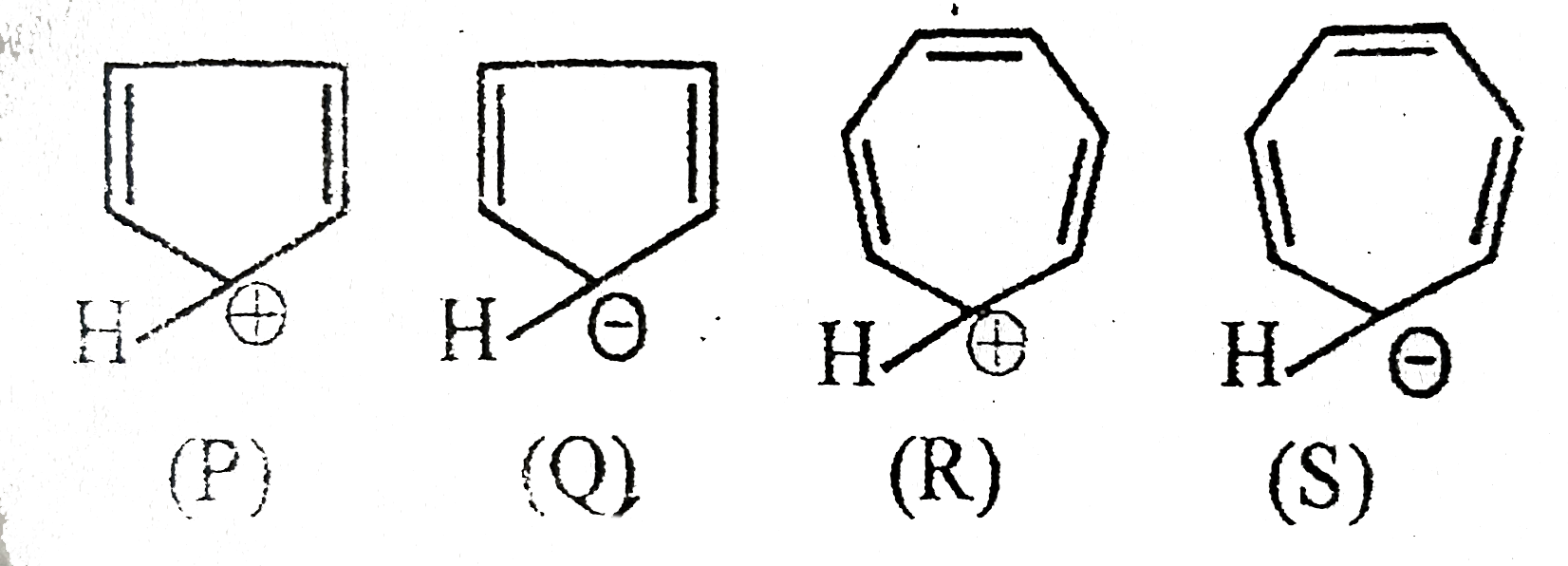Amongst the ions the aromatic specles are :
_E01_214_O01.png)
_E01_214_O02.png)
_E01_214_O03.png)
_E01_214_O04.png)
The correct Answer is:B, C
To determine which of the given ions are aromatic species, we need to apply the four criteria that define aromaticity. Here’s a step-by-step solution:
Step 1: Identify the Criteria for Aromaticity
For a compound to be classified as aromatic, it must satisfy the following four conditions:
1. Cyclic Structure: The molecule must be in a ring form.
2. Planarity: The molecule must be flat, allowing for overlapping p-orbitals.
3. Conjugation: There must be a continuous overlap of p-orbitals, which typically means alternating single and double bonds.
4. Hückel's Rule: The molecule must have 4n+2 π electrons, where n is a non-negative integer (0, 1, 2, ...).
Step 2: Analyze Each Ion
Let’s analyze each of the ions provided in the question based on the criteria:
- Ion A:
- Number of π electrons: 4
- Cyclic: Yes
- Planar: Yes
- Conjugation: Yes
- Conclusion: Fails Hückel's rule (4n π electrons). Thus, it is anti-aromatic.
- Ion B:
- Number of π electrons: 6
- Cyclic: Yes
- Planar: Yes
- Conjugation: Yes
- Conclusion: Satisfies Hückel's rule (4n + 2 where n=1). Thus, it is aromatic.
- Ion C:
- Number of π electrons: 6
- Cyclic: Yes
- Planar: Yes
- Conjugation: Yes
- Conclusion: Satisfies Hückel's rule (4n + 2 where n=1). Thus, it is aromatic.
- Ion D:
- Number of π electrons: 8
- Cyclic: Yes
- Planar: No (non-planar structure)
- Conjugation: Yes
- Conclusion: Fails planarity and Hückel's rule (4n π electrons). Thus, it is non-aromatic.
Step 3: Final Conclusion
Based on the analysis:
- Aromatic Ions: Ion B and Ion C
- Non-aromatic Ion: Ion D
- Anti-aromatic Ion: Ion A
Thus, the aromatic species among the ions are Ion B and Ion C.
For a compound to be classified as aromatic, it must satisfy the following four conditions:
1. Cyclic Structure: The molecule must be in a ring form.
2. Planarity: The molecule must be flat, allowing for overlapping p-orbitals.
3. Conjugation: There must be a continuous overlap of p-orbitals, which typically means alternating single and double bonds.
4. Hückel's Rule: The molecule must have 4n+2 π electrons, where n is a non-negative integer (0, 1, 2, ...).
Let’s analyze each of the ions provided in the question based on the criteria:
- Number of π electrons: 4
- Cyclic: Yes
- Planar: Yes
- Conjugation: Yes
- Conclusion: Fails Hückel's rule (4n π electrons). Thus, it is anti-aromatic.
- Number of π electrons: 6
- Cyclic: Yes
- Planar: Yes
- Conjugation: Yes
- Conclusion: Satisfies Hückel's rule (4n + 2 where n=1). Thus, it is aromatic.
- Number of π electrons: 6
- Cyclic: Yes
- Planar: Yes
- Conjugation: Yes
- Conclusion: Satisfies Hückel's rule (4n + 2 where n=1). Thus, it is aromatic.
- Number of π electrons: 8
- Cyclic: Yes
- Planar: No (non-planar structure)
- Conjugation: Yes
- Conclusion: Fails planarity and Hückel's rule (4n π electrons). Thus, it is non-aromatic.
Based on the analysis:
- Aromatic Ions: Ion B and Ion C
- Non-aromatic Ion: Ion D
- Anti-aromatic Ion: Ion A
Topper's Solved these Questions
- ALKENE, ALKANE & ALKYNE BOOK - ALLENCHAPTER - ALKENE, ALKANE & ALKYNE EXERCISE - EXERCISE-3
99 Videos
- ALKENE, ALKANE & ALKYNE BOOK - ALLENCHAPTER - ALKENE, ALKANE & ALKYNE EXERCISE - EXERCISE-4(A)
10 Videos
- ALKENE, ALKANE & ALKYNE BOOK - ALLENCHAPTER - ALKENE, ALKANE & ALKYNE EXERCISE - EXERCISE-1
119 Videos
- AIIMS 2019BOOK - ALLENCHAPTER - AIIMS 2019EXERCISE - CHEMISTRY
40 Videos
- ALKYL AND ARYL HALIDEBOOK - ALLENCHAPTER - ALKYL AND ARYL HALIDEEXERCISE - EXERCISE-05 (B)
35 Videos
Similar Questions
Knowledge Check
Amongst the ions, the aromatic character is shown by :
 AI and IIIBII and IVCII and IIIDI, II, III and IV
AI and IIIBII and IVCII and IIIDI, II, III and IVAmong the cyclic ions,

the aromatic character is shown by :AP and SBQ and SCQ and RDP, Q, R and S
Which is not an aromatic species?'
View SolutionAmong the following, the aromatic compound is
View SolutionAmongst the following, the amongst base in aquesous medium is….
View SolutionAmongst the following the incorrect order is :-
View SolutionAmongst chordates, the paired appendages are absent in
View Solution
Amongst the following, total no of aromatic compounds are
View Solution

